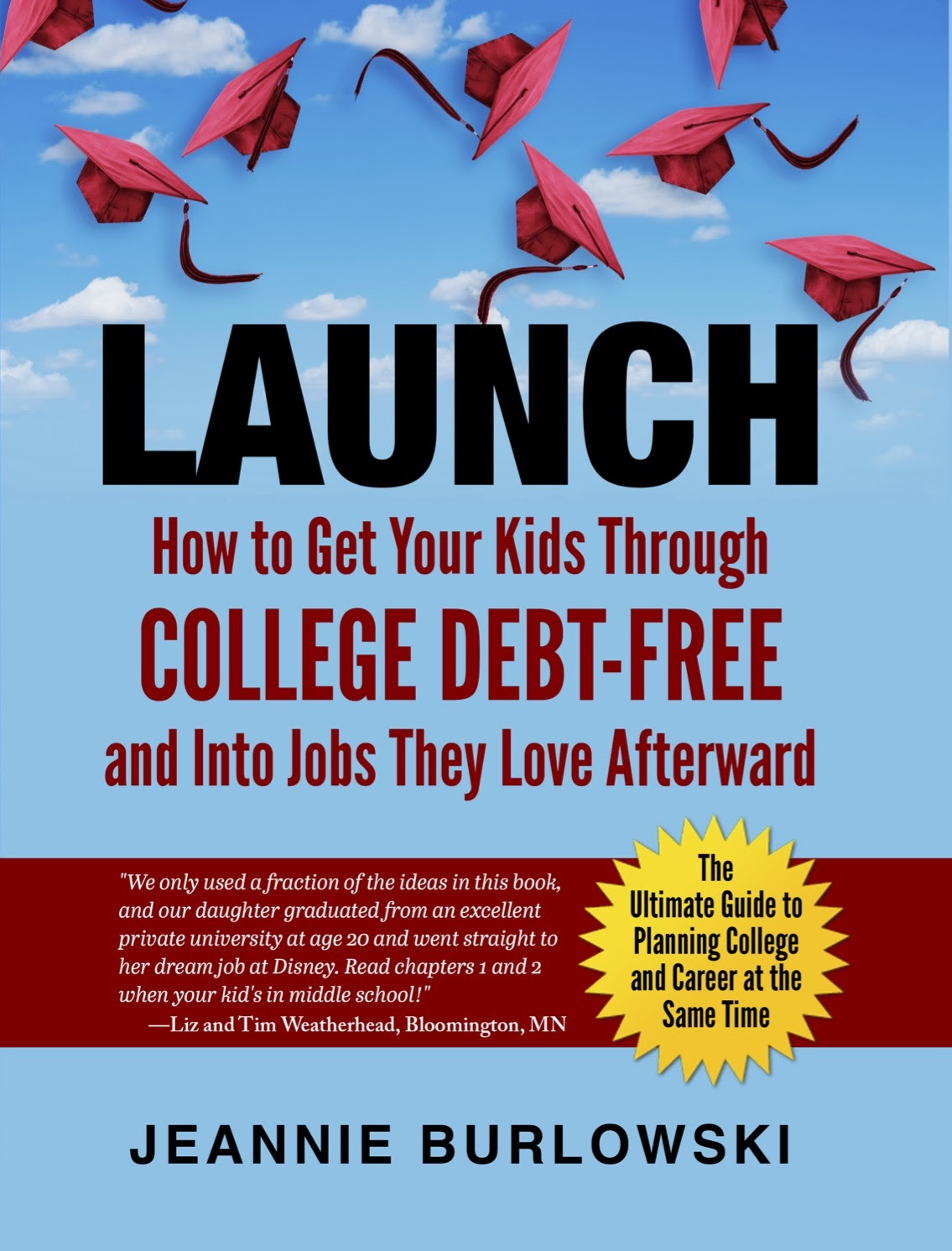A 10th grader writes to tell me that his parents are worried that if he takes dual enrollment college classes in high school, he might be prevented from having “the full high school experience.”
Here’s his email to me:
“Jeannie, I know you strongly recommend dual enrollment college classes in high school for kids who want to get through college debt-free. I want to do dual enrollment full time in 11th and 12th grades so I’ll have two years of college done by the time I graduate from high school. But my parents are trying to steer me toward doing dual enrollment only just part time. They’re worried that if I take a full load of dual enrollment college classes in high school, I’ll miss out on ‘the full high school experience.’ What do you think?”
My answer to him is here:

“Joe, it’s true that I believe that dual enrollment is one of the best tools in the world for getting students through college debt-free.
If you live in one of the 41 states in the U.S. that allow students to take dual enrollment college classes in high school, you’ll be able to take real college courses in place of a good number of your high school classes—and earn high school credit and college credit at the same time. Plus, in many states, the state even pays all the fees involved! How great is that?!?
This is a goldmine for students. In Minnesota, where I live, the state’s dual enrollment program is called “PSEO,” and it’s now in its 38th year of helping high school students save up to $60,000 each on college costs.
But you raise a good question.
Do high school students who leave their high school campuses to take college classes miss out on “the full high school experience”?
A huge percentage of students who’ve been through dual enrollment tell me emphatically, no—they don’t miss out on a full high school experience at all. Whatsoever. Here’s what these students tell me.
Dual enrollment students are still allowed to be as active as they want to be on their high school campuses. They aren’t away, off campus, taking college math and science courses every single minute of every day.
Dual enrollment students show up on their high school campuses during the school day for jazz band, for art and P.E. classes, and for marching band practice, choir rehearsals, and more. At the end of the school day they’re back on their high school campuses for sports practices, school play rehearsals, robotics club competitions, and bus trips to speech tournaments. Dual enrollment students are involved in all the high school clubs and organizations they want to be, and they attend school dances, pep rallies, and high school football games just like non-dual enrollment students do.
One high school senior’s big surprise
One high school girl I encouraged through dual enrollment was surprised, in her senior year of high school, to be elected homecoming queen!
She was so involved at her high school that very few students even realized that she was taking all her substantial high school classes at the college down the road.
The happiest part of her story, though, came when her college registrar called her in for a meeting during the first week after she moved into her fancy private college dormitory when she was 18. “Next semester you’ll be registering as a junior,” the registrar told her. “Just two more years here and you’ll have your bachelor’s degree all sewn up. So be sure to register for next semester’s classes with the juniors—not with the freshmen.”
Student athletes will have a couple of extra things to think about— but that’s OK!
Some student athletes find that driving to late afternoon college classes can interfere with making it to practices.
Besides that, carrying a full load of college classes in high school combined with 100% commitment to a sport can feel like it’s just too much.
For student athletes, I strongly suggest they manage this in two ways:
1. When scheduling college classes during the high school years, work hard to insist that your late afternoons must be kept free for sports practices.
2. Be sure to take my 1/2-day seminar THE STRATEGIC COLLEGE STUDENT: How to Get Higher Grades While Studying Less Than Most Other People. This 1/2-day seminar is ideal for students who want to achieve at highest levels, but have other things going on in their lives besides academic work. This 1/2-day seminar is offered free, twice each year, for families inside my TRIBE Membership. But anyone can purchase it at any time for $295.00 by emailing me at jeannie@jeannieburlowski.com.
So what’s the upshot?
Student, if you can take a full load of college classes as an 11th grader, I strongly encourage you to max out dual enrollment. Take as full a load of dual enrollment classes as your state will pay for.
Learn more about dual enrollment (including how to sign up for it) in my book, on pages 92–95.
Are you worried you won’t be able to handle taking actual college classes in high school?
Build your confidence and your ability by taking my 1/2-day seminar THE STRATEGIC COLLEGE STUDENT: How to Get Higher Grades While Studying Less Than Most Other People. Learn about it here.
You can see students ages 12–26 raving about this class here.
Find out when I’m next teaching this class live by subscribing to my free email newsletter here.
Do your parents feel hesitant about having you on a college campus when you’re only 16?
You may be able to take dual enrollment college courses through a private or public university’s “distance education” program.
Classes done this way are all online, so you can do them from your school library, or from home. In Minnesota, where I live, the most popular place for students to earn online dual enrollment college credits is the University of Northwestern in St. Paul. (Formerly Northwestern College.) If you’re a Minnesotan, you can learn more about dual enrollment at the University of Northwestern here.
Does your state offer “dual enrollment”?
To see whether your state offers dual enrollment (including whether your state will pay for it), google the name of your state along with the words “dual enrollment” or “concurrent enrollment.”
Remember, Advanced Placement (AP) classes are not anywhere near as helpful as taking dual enrollment college classes in high school. The reason? Too many students who get good scores on AP tests are not able to actually get the free college credit promised. You can see the article I’ve written on this subject here.
Here’s more helpful info about dual enrollment: Should Teens Take College Classes in 11th Grade?
Help us spread the word on this!
Copy this entire article and paste it right into your school, business, or nonprofit newsletter. Put a link to it in your Facebook group! Just include the words “By Jeannie Burlowski.”
I provide additional important information on this subject in chapters 9, 12, 14, 16, and 17 of my book:
Important—> It’s a reference book, so nobody reads the whole thing cover to cover. Pick out what you need to read in it using the fast-paced, 10-minute video instructions here.
You can see hundreds of reviews of this book on Amazon by going to:
Read just one chapter of LAUNCH every 1–3 months while your child’s in middle school and high school, and you’ll know every viable strategy for debt-free college at exactly the right time to implement it.
And if your child’s already well past middle school? That’s OK; you can run to catch up. But the process of getting your kids through college debt-free goes more smoothly the earlier you start—especially if you’re not planning to save up any money to pay for college.
Let's you and I walk together toward the goal of debt-free college for your kids.
We can accomplish this no matter your current income level—even if your kids never get a single scholarship.
Your first step is getting regularly scheduled, free helpful articles from me—right in your email inbox. Quick, sign up here.
Do you have very specific questions for me about debt-free college and career for your kids?
My TRIBE Members get the most direct access to me—while feeling good that the pennies per day they spend on the TRIBE help me bring debt-free college strategy to families who could never afford to pay for it. Join my TRIBE Membership waiting list here.
Who is Jeannie Burlowski?
Jeannie is a full-time academic strategist, podcast host, and sought-after speaker for students ages 12–26, their parents, and the professionals who serve them. Her writing, speaking, and podcasting help parents set their kids up to graduate college debt-free, ready to jump directly into careers they excel at and love. Her work has been featured in publications such as The Huffington Post, USA Today, Parents Magazine, and US News & World Report, as well as on CBS News.
Jeannie also helps students apply to law, medical, business, and grad school at her website GetIntoMedSchool.com. You can follow her on Bluesky @jburlowski.bsky.social.
No part of this article was written using AI.
This article was updated on July 11th, 2025.


